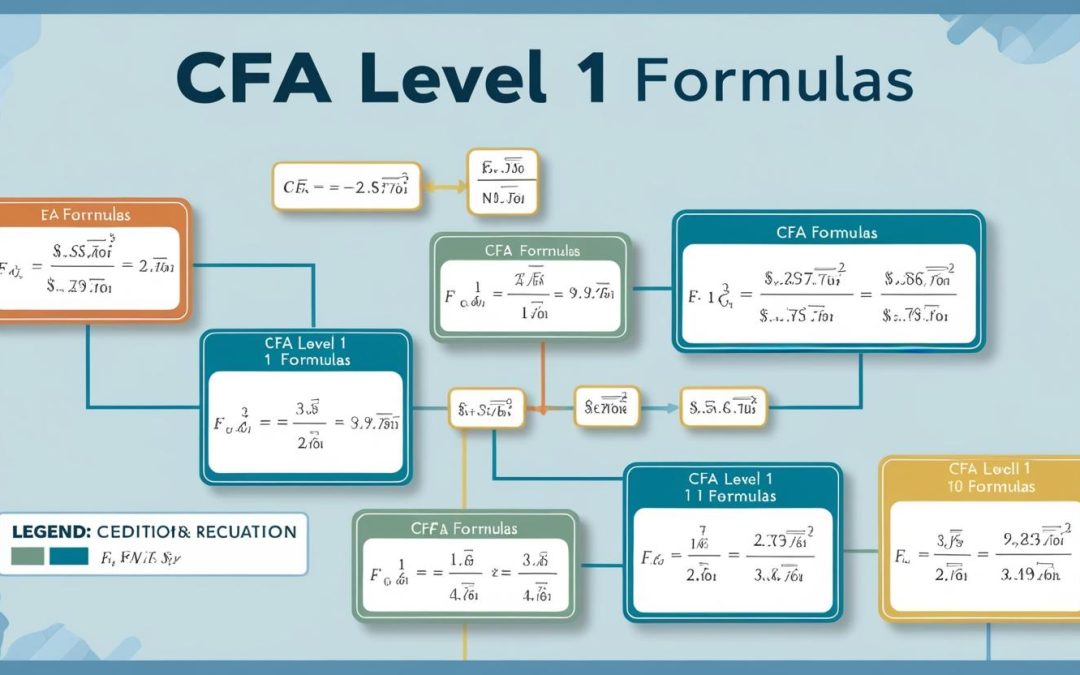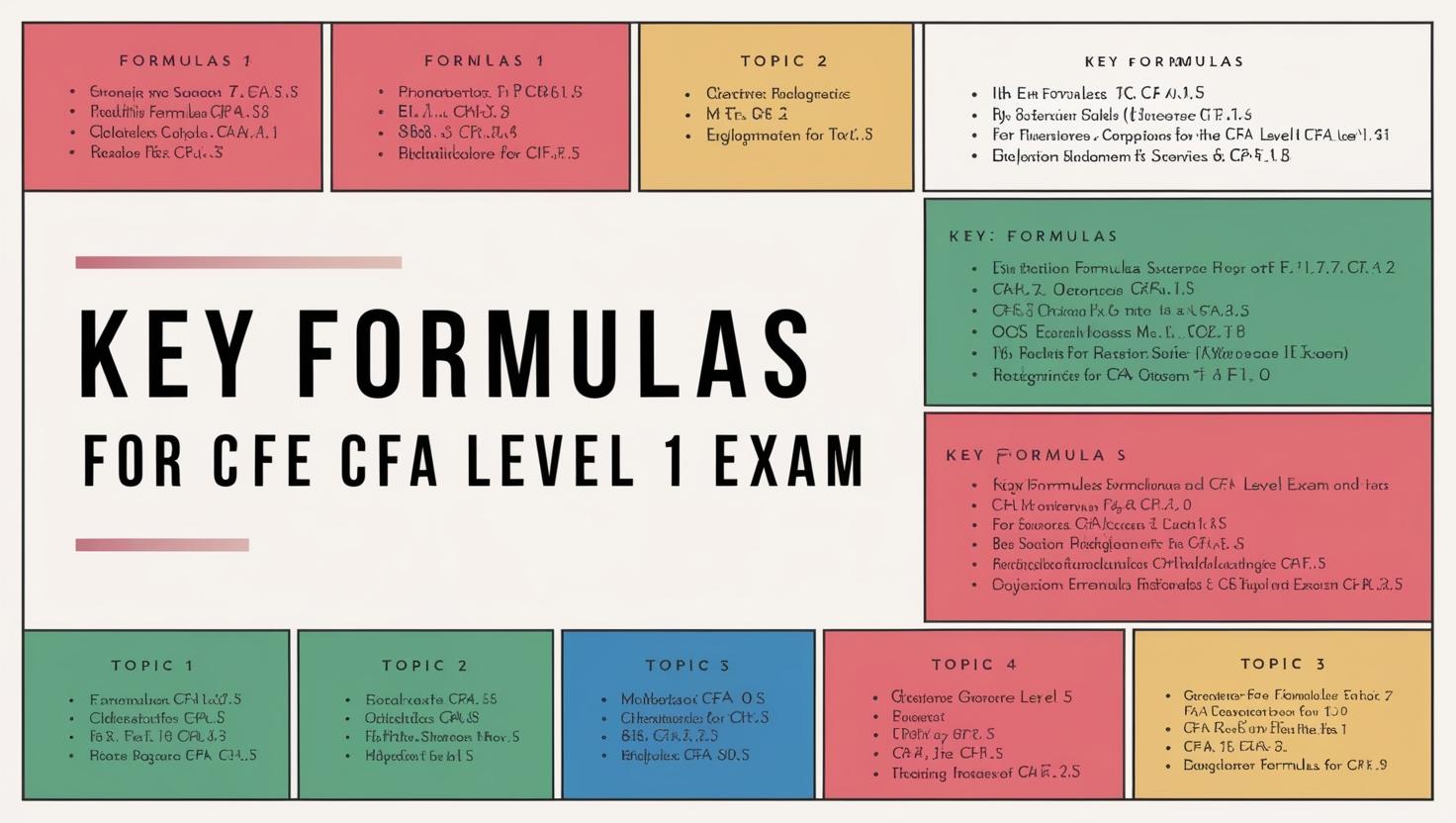If you're preparing for the CFA Level 1 exam, you're probably feeling a mix of excitement, determination, and maybe a little bit of stress. The CFA (Chartered Financial Analyst) certification is a significant milestone in your finance career, and Level 1 is your first step toward achieving that prestigious credential. One of the challenges you’ll face is mastering the vast number of formulas that appear in the exam. But don't worry. At takemycfaexam.com, we’ve got you covered with all the formulas you need to memorize for your CFA Level 1 exam.
Let’s break it down, so you can approach this challenge with confidence and clarity.
Why Are Formulas Important for the CFA Level 1 Exam?
The CFA Level 1 exam covers a wide range of topics, from financial reporting to quantitative methods. Formulas are essential because they provide the foundation for solving many of the questions you'll encounter on the test. In fact, about 70% of the exam is comprised of multiple-choice questions where understanding and applying formulas is key.
While the CFA Institute provides a formula sheet during the exam, it's crucial to memorize and understand these formulas beforehand. This will allow you to quickly recall them during the exam and use them effectively to solve problems.
Key Categories of Formulas to Memorize
Here’s a breakdown of the most important formulas by topic. Make sure you have a solid grasp on each one
1. Quantitative Methods
Quantitative methods are crucial for solving a variety of problems related to statistics, probability, and time value of money. Key formulas include:
-
Time Value of Money (TVM):
-
Future Value (FV):
FV=PV×(1+r)nFV = PV \times (1 + r)^n -
Present Value (PV):
PV=FV(1+r)nPV = \frac{FV}{(1 + r)^n}
-
-
Net Present Value (NPV):
-
NPV=∑Ct(1+r)t−I0NPV = \sum \frac{C_t}{(1 + r)^t} – I_0 where CtC_t = cash flow at time t, rr = discount rate, and I0I_0 = initial investment.
-
-
Standard Deviation and Variance:
-
Variance (σ²):
σ2=∑(Xi−μ)2n\sigma^2 = \frac{\sum (X_i – \mu)^2}{n} -
Standard Deviation (σ):
σ=σ2\sigma = \sqrt{\sigma^2}
-
2. Financial Reporting and Analysis
This section tests your ability to interpret financial statements and apply accounting concepts. Memorize these formulas to ensure success:
-
Earnings Per Share (EPS):
-
EPS=Net Income−Preferred DividendsWeighted Average Shares OutstandingEPS = \frac{Net\:Income – Preferred\:Dividends}{Weighted\:Average\:Shares\:Outstanding}
-
-
Return on Equity (ROE):
-
ROE=Net IncomeShareholders’ EquityROE = \frac{Net\:Income}{Shareholders’\:Equity}
-
-
Return on Assets (ROA):
-
ROA=Net IncomeTotal AssetsROA = \frac{Net\:Income}{Total\:Assets}
-
3. Corporate Finance
In corporate finance, formulas help you assess investment decisions, capital budgeting, and risk. Some key formulas include:
-
Weighted Average Cost of Capital (WACC):
-
WACC=EV×Re+DV×Rd×(1−Tc)WACC = \frac{E}{V} \times Re + \frac{D}{V} \times Rd \times (1 – Tc) where EE = equity, DD = debt, VV = total value, ReRe = cost of equity, RdRd = cost of debt, and TcTc = tax rate.
-
-
Dividend Discount Model (DDM):
-
P0=D1r−gP_0 = \frac{D_1}{r – g} where P0P_0 = price of the stock today, D1D_1 = dividend in the next period, rr = required rate of return, and gg = growth rate of dividends.
-
4. Equity Investments
In equity investments, focus on the following formulas:
-
Price-to-Earnings Ratio (P/E):
-
P/E=Price Per ShareEarnings Per ShareP/E = \frac{Price\:Per\:Share}{Earnings\:Per\:Share}
-
-
Dividend Yield:
-
Dividend Yield=Annual Dividend Per SharePrice Per ShareDividend\:Yield = \frac{Annual\:Dividend\:Per\:Share}{Price\:Per\:Share}
-
-
Capital Asset Pricing Model (CAPM):
-
Ri=Rf+βi(Rm−Rf)R_i = R_f + \beta_i (R_m – R_f) where RiR_i = expected return, RfR_f = risk-free rate, βi\beta_i = stock’s beta, and RmR_m = expected market return.
-
5. Fixed Income
In fixed income, formulas help you calculate bond prices, yields, and durations. A few examples are:
-
Bond Price:
-
P=∑C(1+r)t+F(1+r)TP = \sum \frac{C}{(1 + r)^t} + \frac{F}{(1 + r)^T} where PP = bond price, CC = coupon payment, rr = discount rate, FF = face value, and TT = time to maturity.
-
-
Duration (Macaulay):
-
D=∑t×C(1+r)tPD = \frac{\sum \frac{t \times C}{(1 + r)^t}}{P}
-
How to Memorize CFA Level 1 Formulas
While memorizing formulas is essential, understanding their application is just as important. Here are a few tips to help you remember and apply them:
-
Understand the Concept First: Rather than just memorizing the formulas, try to understand the underlying concepts. This will make it easier to remember how and when to use them.
-
Practice, Practice, Practice: The more problems you solve using these formulas, the more familiar they will become. Practice on mock exams, quizzes, and past papers to reinforce your understanding.
-
Use Flashcards: Create flashcards for each formula and regularly quiz yourself. This can help with memorization and recall during the exam.
-
Create Mnemonics: Try using mnemonics or memory aids to remember complex formulas. For example, “Please Excuse My Dear Aunt Sally” for the order of operations in math.
-
Focus on High-Impact Formulas: Prioritize the formulas that appear most frequently in past exams and have the highest weight in the curriculum. These are often found in sections like Financial Reporting, Corporate Finance, and Quantitative Methods.
Frequently Asked Questions (FAQs)
1. Do I need to memorize all the formulas for the CFA Level 1 exam?
You should aim to memorize the most important formulas, but don't stress about memorizing every single one. The CFA Institute provides a formula sheet during the exam, but you’ll still need to be able to apply them quickly and efficiently.
2. How long does it take to memorize all the formulas?
It varies depending on your study habits and familiarity with the material. Some candidates may take a few weeks, while others might take longer. Consistent practice and reviewing your notes can help speed up the process.
3. What should I do if I forget a formula during the exam?
Don’t panic! Use the formula sheet provided, and try to piece together the information based on what you remember. You can also use logical reasoning to approximate the solution.
4. Are there any formulas I should focus on more than others?
Yes! Pay extra attention to formulas in high-weight sections like Quantitative Methods, Corporate Finance, and Financial Reporting. These are often the most heavily tested areas.
Conclusion
Mastering the formulas for the CFA Level 1 exam can seem daunting, but with a clear strategy and consistent practice, you’ll be able to approach the exam with confidence. At takemycfaexam.com, we’re here to support you every step of the way in your journey to becoming a CFA charter holder.
Remember, formulas are just one part of the exam, but they’re an essential one. Keep practicing, stay focused, and soon you'll be walking into that exam with all the formulas firmly in your grasp. Good luck.
This article is designed to not only provide valuable information but also keep the tone light, motivating, and student-friendly. If you're feeling stressed about the CFA Level 1, know that you're not alone – keep pushing, and you'll get there.


